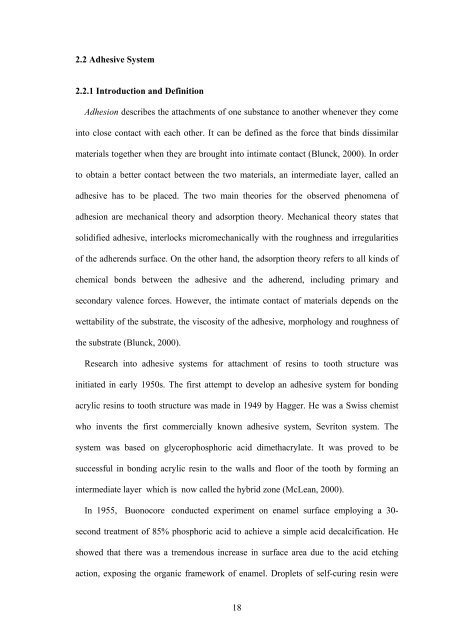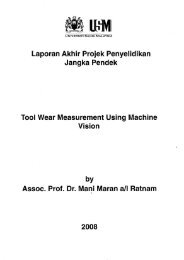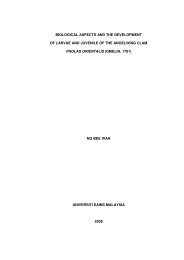microleakage in class ii composite restorations ... - ePrints@USM
microleakage in class ii composite restorations ... - ePrints@USM
microleakage in class ii composite restorations ... - ePrints@USM
You also want an ePaper? Increase the reach of your titles
YUMPU automatically turns print PDFs into web optimized ePapers that Google loves.
2.2 Adhesive System2.2.1 Introduction and Def<strong>in</strong>itionAdhesion describes the attachments of one substance to another whenever they come<strong>in</strong>to close contact with each other. It can be def<strong>in</strong>ed as the force that b<strong>in</strong>ds dissimilarmaterials together when they are brought <strong>in</strong>to <strong>in</strong>timate contact (Blunck, 2000). In orderto obta<strong>in</strong> a better contact between the two materials, an <strong>in</strong>termediate layer, called anadhesive has to be placed. The two ma<strong>in</strong> theories for the observed phenomena ofadhesion are mechanical theory and adsorption theory. Mechanical theory states thatsolidified adhesive, <strong>in</strong>terlocks micromechanically with the roughness and irregularitiesof the adherends surface. On the other hand, the adsorption theory refers to all k<strong>in</strong>ds ofchemical bonds between the adhesive and the adherend, <strong>in</strong>clud<strong>in</strong>g primary andsecondary valence forces. However, the <strong>in</strong>timate contact of materials depends on thewettability of the substrate, the viscosity of the adhesive, morphology and roughness ofthe substrate (Blunck, 2000).Research <strong>in</strong>to adhesive systems for attachment of res<strong>in</strong>s to tooth structure was<strong>in</strong>itiated <strong>in</strong> early 1950s. The first attempt to develop an adhesive system for bond<strong>in</strong>gacrylic res<strong>in</strong>s to tooth structure was made <strong>in</strong> 1949 by Hagger. He was a Swiss chemistwho <strong>in</strong>vents the first commercially known adhesive system, Sevriton system. Thesystem was based on glycerophosphoric acid dimethacrylate. It was proved to besuccessful <strong>in</strong> bond<strong>in</strong>g acrylic res<strong>in</strong> to the walls and floor of the tooth by form<strong>in</strong>g an<strong>in</strong>termediate layer which is now called the hybrid zone (McLean, 2000).In 1955, (Buonocore, conducted experiment on enamel surface employ<strong>in</strong>g a 30-second treatment of 85% phosphoric acid to achieve a simple acid decalcification. Heshowed that there was a tremendous <strong>in</strong>crease <strong>in</strong> surface area due to the acid etch<strong>in</strong>gaction, expos<strong>in</strong>g the organic framework of enamel. Droplets of self-cur<strong>in</strong>g res<strong>in</strong> were18
















